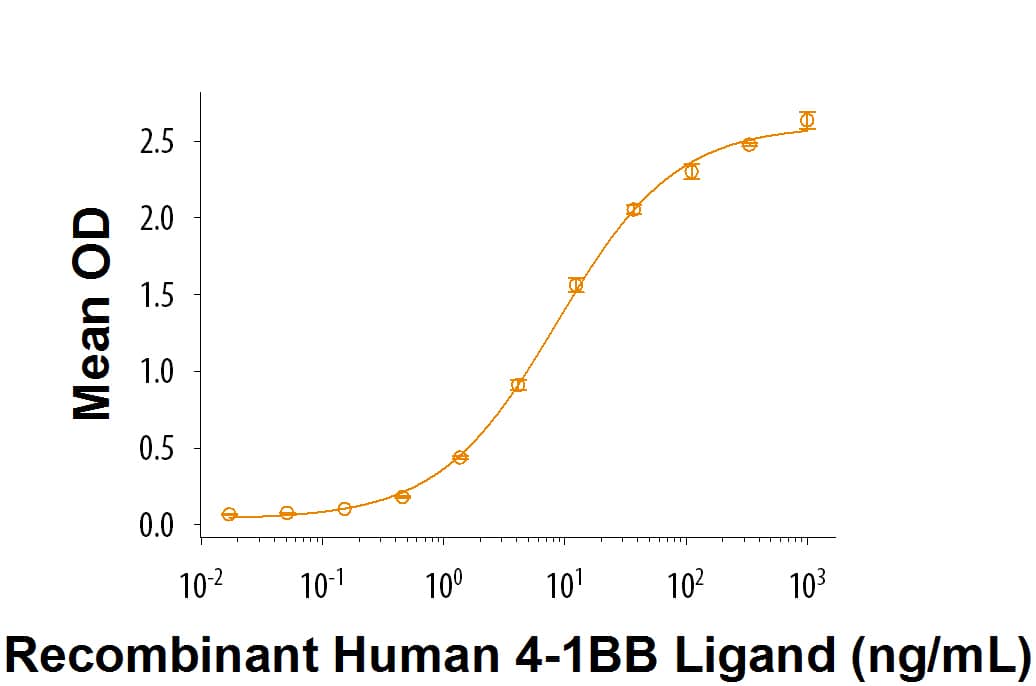Recombinant Human 4-1BB/TNFRSF9 His-tag Protein, CF
R&D Systems, part of Bio-Techne | Catalog # 9220-4B
Analyzed by SEC-MALS.

Key Product Details
Product Specifications
Source
Chinese Hamster Ovary cell line, CHO-derived human 4-1BB/TNFRSF9/CD137 protein
Leu24-His183, with a C-terminal 6-His tag
Leu24-His183, with a C-terminal 6-His tag
Purity
>95%, by SDS-PAGE visualized with Silver Staining and quantitative densitometry by Coomassie® Blue Staining.
Endotoxin Level
<0.10 EU per 1 μg of the protein by the LAL method.
N-terminal Sequence Analysis
Leu24
Predicted Molecular Mass
18 kDa
SDS-PAGE
25-38 kDa, reducing conditions
Activity
Measured by its binding ability in a functional ELISA.
When Recombinant Human 4-1BB/TNFRSF9/CD137 is immobilized at 50 ng/mL, 100 μL/well, the concentration of Recombinant Human 4‑1BB Ligand/TNFSF9 (Catalog # 2295-4L) that produces 50% of the optimal binding response is approximately 2.5-12.5 ng/mL.
When Recombinant Human 4-1BB/TNFRSF9/CD137 is immobilized at 50 ng/mL, 100 μL/well, the concentration of Recombinant Human 4‑1BB Ligand/TNFSF9 (Catalog # 2295-4L) that produces 50% of the optimal binding response is approximately 2.5-12.5 ng/mL.
Reviewed Applications
Read 2 reviews rated 4.5 using 9220-4B in the following applications:
Scientific Data Images for Recombinant Human 4-1BB/TNFRSF9 His-tag Protein, CF
Recombinant Human 4‑1BB/TNFRSF9/CD137 Protein SEC-MALS.
Recombinant Human 4-1BB/TNFRSF9 (Catalog # 9220-4B) has a molecular weight (MW) of 21.8 kDa as analyzed by SEC-MALS, suggesting that this protein is a monomer. MW may differ from predicted MW due to post-translational modifications (PTMs) present (i.e. Glycosylation).Recombinant Human 4-1BB/TNFRSF9 His-tag Protein Bioactivity
When Recombinant Human 4-1BB/TNFRSF9 (Catalog # 9220-4B) is coated at 50 ng/mL, Recombinant Human 4-1BB Ligand/TNFSF9 Recombinant Human 4-1BB Ligand/ TNFSF9 (Catalog # 2295-4L) binds with a ED50 of 2.5-15 ng/mL.Formulation, Preparation and Storage
9220-4B
| Formulation | Lyophilized from a 0.2 μm filtered solution in PBS. |
| Reconstitution |
Reconstitute at 500 μg/mL in PBS.
|
| Shipping | The product is shipped with polar packs. Upon receipt, store it immediately at the temperature recommended below. |
| Stability & Storage | Use a manual defrost freezer and avoid repeated freeze-thaw cycles.
|
Background: 4-1BB/TNFRSF9/CD137
4-1BB activation enhances CD8+ T cell and NK cell mediated anti-tumor immunity (14). It also contributes to the development of inflammation in high fat diet-induced metabolic syndrome (15). Soluble forms of 4-1BB and 4-1BB Ligand circulate at elevated levels in the serum of rheumatoid arthritis and hematologic cancer patients, respectively (16, 17).
References
- Wang, C. et al. (2009) Immunol. Rev. 229:192.
- Schwarz, H. et al. (1993) Gene 134:295.
- Alderson, M.R. et al. (1994) Eur. J. Immunol. 24:2219.
- Wen, T. et al. (2002) J. Immunol. 168:4897.
- Pulle, G. et al. (2006) J. Immunol. 176:2739.
- Zheng, G. et al. (2004) J. Immunol. 173:2428.
- Kim, D. et al. (2008) J. Immunol. 180:2062.
- Lee, S. et al. (2008) Nat. Immunol. 9:917.
- Choi, B.K. et al. (2009) J. Immunol. 182:4107.
- Nishimoto, H. et al. (2005) Blood 106:4241.
- Saito, K. et al. (2004) J. Biol. Chem. 279:13555.
- Lee, S. et al. (2005) J. Immunol. 174:6803.
- Ma, B.Y. et al. (2005) Blood 106:2002.
- Choi, B.K. et al. (2010) J. Immunol. 185:1404.
- Kim, C. et al. (2011) Diabetes 60:3159.
- Michel, J. et al. (1998) Eur. J. Immunol. 28:290.
- Salih, H.R. et al. (2001) J. Immunol. 167:4059.
Alternate Names
41BB, CD137, ILA, TNFRSF9
Gene Symbol
TNFRSF9
UniProt
Additional 4-1BB/TNFRSF9/CD137 Products
Product Documents for Recombinant Human 4-1BB/TNFRSF9 His-tag Protein, CF
Product Specific Notices for Recombinant Human 4-1BB/TNFRSF9 His-tag Protein, CF
For research use only
